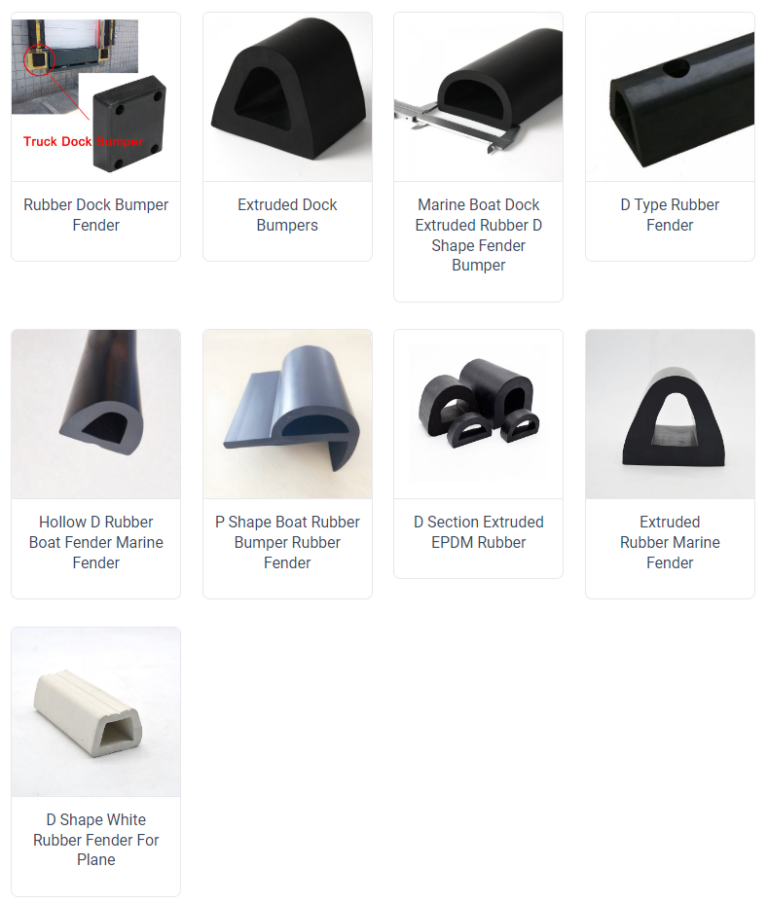Water vehicles like boats and ships face extreme thrust and propulsion during docking. These vehicles may get scratched or severely damaged if we don’t take the necessary steps. Therefore, we find solutions to mitigate this problem. A Rubber Fender absorbs this thrust and propulsion and protects the vehicle during docking.
A rubber fender is a cushioning equipment made from elastomeric materials. They are usually designed to absorb and dissipate kinetic energy. Docks and water vehicles both require high-quality rubber fenders to absorb this energy. Otherwise, the consequences may be severe. Essentially, a rubber fender acts as the silent guardian of maritime operations.
Therefore, we must recognize the significance of rubber fenders. Most ports, harbors, and offshore facilities ensure this as their first line of defense. This defense system primarily absorbs collisions and impacts. As a result, they can protect the vessels and structures involved and ensure the crew’s safety. In addition, a rubber fender contributes to cost savings by reducing maintenance.
Today’s article aims to highlight the fundamentals of a rubber fender. The following sections especially delve into the types, functions, applications, and benefits. In addition, we will learn some tips for maintaining the rubber fender for more extended durability.

What is Rubber Fender?
A rubber fender is a specialized protective equipment made from elastomeric materials. The manufacturing process involves five primary steps:
- The process begins with the material selections.
- The chosen rubber material is mixed with various additives.
- The mold or dies shape the rubber compounds into the desired fender profile.
- The vulcanization process crosslinks the rubber molecules to make them more efficient.
- The manufactured rubber fenders undergo various quality control checks.
The manufactured rubber fender then provides a wide range of physical properties. These properties may vary based on different applications.
Elasticity
Rubber fenders are highly elastic. In this case, they allow them to deform and absorb impact energy during collisions. Then, it returns to its original shape.
Tensile Strength
A rubber fender usually provides excellent tensile strength. It means that they can withstand large stretching forces without breaking.
Resistance
A rubber fender is also resistant to various environmental factors. For example, abrasion, weather, chemicals, and temperature are noteworthy.
Compression Set Resistance
A rubber fender has good resistance to compression set. It can maintain its shape and performance even after prolonged squeezes. It also ensures the durability of the product.
How Does A Rubber Fender Work?
A rubber fender works on the principle of elasticity and molecular deformation. The process absorbs and dissipates kinetic energy during collision or contact with structures.
We know that Fender rubber seals are synthetic rubber compounds. It is composed of long polymer chains. These polymer chains are highly flexible and famous for elasticity. When a collision occurs, it exerts a certain amount of pressure on the rubber surface. The polymer chains then start to stretch and deform. Note that when a force is applied through polymer chains, it causes them to align in the direction of the applied force. As the chains stretch, they absorb and store the energy from the collision as potential energy.
Once the external force is removed, the polymer chains naturally return to their relaxed state. At this moment, they release the stored potential energy gradually. This absorbed energy is converted into heat and released through different mediums. This releasing energy mechanism acts as a cushioning method. It reduces the impact force transmitted to the vessel or structure.
Rubber fenders utilize this technique to absorb and gradually release the energy from collisions. This elasticity and molecular level deformation prevents damage to vessels and structures.
Advantages of Using Rubber Fender
The working principle of rubber fenders highlights that this compound provides a wide range of benefits. For example, it offers excellent shock absorption capability. Therefore, various industries utilize rubber fenders due to their unique properties and design. Here are some key benefits of using rubber fenders:
- A fender rubber seal protects both vessels and structures from damage. It also increases safety from accidents and injuries.
- It also reduces maintenance and repair costs.
- A rubber fender is a versatile option. It comes in various shapes and sizes.
- They are easy to install, which reduces downtime during setup.
- Rubber fenders can accommodate various environmental factors. They also can adapt to changes in water levels and tides.
- Rubber fenders help reduce noise during docking and mooring.
- These rubber products are customizable. So, It can meet specific requirements like size, shape, and performance characteristics.
What Are Rubber Fenders Used For?
Rubber fenders find diverse applications across various industries. Their exceptional shock absorption capability makes them versatile in many applications. Here are some key sectors where rubber fenders are popular:
Ports And Harbors
Dock fenders are usually installed along the quay walls and docks. They shield vessels during docking and mooring operations. Dock fenders are crucial safeguards and prevent damage to water vehicles and the port. They ensure efficient maritime operations.
Shipping Industry
Boat and dock fenders are prevalent for manufacturing ships and vessels of all sizes. These rubber fenders on the boat protect the hull from collisions with other water vehicles. It also protects the hull from locks or piers.
Marine Terminals
Marine rubber fenders are essential at marine terminals. They shield loading and unloading equipment like cranes and cargo handling machinery. Marine rubber fenders ensure a secure and smooth transfer of goods.
Trucks And Lorries
Beyond maritime applications, rubber fenders can also be seen in the automotive industry. Trucks and lorries use rubber fenders to protect themselves from collisions and impacts. These rubber products safeguard both the vehicle and nearby structures.
Building Interiors
Rubber fenders are integrated into the building interior to cushion impacts. These rubber products are used in high-traffic areas like parking garages and warehouses. They help prevent damage to walls, columns, and vehicles in indoor environments.
Recreational Boating
Boat dock fenders are prevalent in recreational boating manufacturing. These rubber products are used on boats and yachts to prevent hull damage during docking and mooring. These fenders ensure the longevity of vessels while maintaining aesthetics and functionality.
Types of Rubber Fender
Rubber fenders come in various types, each subjected to specific applications. The fender types range from protecting boats and docks to automotive and aerospace. Here are some popular rubber fender types.

Rubber Boat Fenders
These rubber fenders are designed to shield small boats and watercraft during docking. Rubber boat fenders are often cylindrical or D-shaped. “Marine boat dock extruded D-shaped rubber” and “D-type rubber fenders” are noteworthy examples.
Dock Fenders
Dock fenders are typically used in ports and harbors. They are strategically installed along quay walls and docks. It safeguards both vessels and the port infrastructure during docking and mooring. For example, “extruded rubber boat dock bumper” is noteworthy.
Bumper Dock Fenders
These rubber fenders are prevalent in heavy-duty applications. For example, these rubber fenders protect piers and docks from larger vessels like cargo ships and oil tankers. For example, “Boat dock fender bumper” is a noteworthy example.
Marine Rubber Fenders
Marine fenders also come in various types, like cylindrical or D-shaped. These rubber fenders are specially tailored for marine applications. For example, “Hollow D Marine rubber fenders” and “Extruder Rubber Marine Fender” are noteworthy.
D Shape Rubber Fender For Plane
This type of white rubber fender is applied to the plane. You may find these fenders on pylon and platform ladders, passenger stairs, and double-ended platforms. “D-shaped rubber fender for the plane” is the perfect example.
Pneumatic Fenders
These rubber fenders are inflatable boat fenders filled with high-pressure air. They are often used in ship-to-ship transfers.
Arch Fenders
Arch fenders are a single piece of rubber molding. The design might be simple but yet rugged. These rubber fenders provide cushioning services for a wide range of berths. They operate even under the most severe conditions.
FAQs
- Why are marine fenders essential?
Answer: Marine fenders are crucial for protecting both vessels and maritime infrastructure. They typically absorb and dissipate kinetic energy during collisions. It prevents damage to ships, docks, quay walls, and other structures.
- What is the function of fenders on a boat?
Answer: Fenders on a boat provide cushioning and protect the vessel during docking and mooring. They absorb impact energy. It prevents damage to the boat’s hull. Ultimately, it ensures safety and damage-free berthing.
- What is the purpose of fender covers, and when should they be used?
Answer: Fender covers are used to protect the fenders themselves. They serve as a protective layer, shielding the fenders from various environmental factors. Some factors include abrasion, UV radiation, and general wear and tear.
- What do fenders prevent?
Answer: Fenders prevent damage primarily to vessels and maritime infrastructure. They prevent damage caused by collisions during berthing, mooring, or docking operations. Fenders also help prevent injuries. We may find these rubber fenders in other applications. They mainly serve as a protection gurdian.
- What is the difference between buoys and fenders?
Answer: Buoys and fenders have different purposes in maritime applications. Buoys are floating markers used for navigation or safe passage. They are not designed for impact protection. On the other hand, rubber fenders are specially designed to absorb and dissipate energy during collisions. It safeguards the water vehicles and infrastructure.
